Semiempirical Two-Dimensional Model of the Bipolar Resistive Switching Process in Si-NCs/SiO2 Multilayers
Abstract
1. Introduction
2. Materials and Methods
3. Bipolar Resistive Switching Based on Deoxidation–Oxidation Model
4. Oxygen Vacancy Configurations to Obtain the Resistive States
5. Conduction Mechanisms at Different Resistive States
6. Simulation and Results
6.1. FORMING and SET Process
6.2. RESET Process
7. Conclusions
Author Contributions
Funding
Data Availability Statement
Acknowledgments
Conflicts of Interest
References
- Zahoor, F.; Azni Zulkifli, T.Z.; Khanday, F.A. Resistive Random Access Memory (RRAM): An Overview of Materials, Switching Mechanism, Performance, Multilevel Cell (mlc) Storage, Modeling, and Applications. Nanoscale Res. Lett. 2020, 15, 90. [Google Scholar] [CrossRef] [PubMed]
- Chen, H.Y.; Brivio, S.; Chang, C.C.; Frascaroli, J.; Hou, T.H.; Hudec, B.; Liu, M.; Lv, H.; Molas, G.; Sohn, J.; et al. Resistive random access memory (RRAM) technology: From material, device, selector, 3D integration to bottom-up fabrication. J. Electroceram. 2017, 39, 21–38. [Google Scholar] [CrossRef]
- Shen, Z.; Zhao, C.; Qi, Y.; Xu, W.; Liu, Y.; Mitrovic, I.Z.; Yang, L.; Zhao, C. Advances of RRAM Devices: Resistive Switching Mechanisms, Materials and Bionic Synaptic Application. Nanomaterials 2020, 10, 1437. [Google Scholar] [CrossRef]
- Lanza, M.; Wong, H.S.; Pop, E.; Ielmini, D.; Strukov, D.; Regan, B.C.; Larcher, L.; Villena, M.A.; Yang, J.J.; Goux, L.; et al. Recommended Methods to Study Resistive Switching Devices. Adv. Electron. Mater. 2018, 5, 1800143. [Google Scholar] [CrossRef]
- Aldana, S.; Garciá-Fernández, P.; Romero-Zaliz, R.; González, M.B.; Jiménez-Molinos, F.; Gómez-Campos, F.; Campabadal, F.; Roldán, J.B. Resistive switching in HfO2 based valence change memories, a comprehensive 3D kinetic Monte Carlo approach. J. Phys. Appl. Phys. 2020, 53, 225106. [Google Scholar] [CrossRef]
- Hu, C.; Wang, Q.; Bai, S.; Xu, M.; He, D.; Lyu, D.; Qi, J. The effect of oxygen vacancy on switching mechanism of ZnO resistive switching memory. Appl. Phys. Lett. 2017, 110, 2–5. [Google Scholar] [CrossRef]
- Carta, D.; Salaoru, I.; Khiat, A.; Regoutz, A.; Mitterbauer, C.; Harrison, N.M.; Prodromakis, T. Investigation of the Switching Mechanism in TiO2-Based RRAM: A Two-Dimensional EDX Approach. ACS Appl. Mater. Interfaces 2016, 8, 19605–19611. [Google Scholar] [CrossRef] [PubMed]
- Ding, Y.; Yuan, P.; Yu, J.; Chen, Y.; Jiang, P.; Wang, Y.; Xu, Y.; Lv, S.; Dang, Z.; Wang, B.; et al. Forming-Free NbOx-Based Memristor Enabling Low-Energy-Consumption Artificial Spiking Afferent Nerves. IEEE Trans. Electron Devices 2022, 69, 5391–5394. [Google Scholar] [CrossRef]
- Jiang, P.F.; Gao, H.X.; Yang, M.; Zhang, Z.F.; Ma, X.H.; Yang, Y.T. Enhanced Switching Stability in Forming-Free SiNx Resistive Random Access Memory Devices with Low Power Consumptions Based on Local Pt Doping in a Stacked Structure. Adv. Electron. Mater. 2019, 5, 1800739. [Google Scholar] [CrossRef]
- Rahmani, M.K.; Ismail, M.; Mahata, C.; Kim, S. Effect of interlayer on resistive switching properties of SnO2-based memristor for synaptic application. Results Phys. 2020, 18, 103325. [Google Scholar] [CrossRef]
- Jiang, P.; Xu, K.; Yu, J.; Xu, Y.; Yuan, P.; Wang, Y.; Chen, Y.; Ding, Y.; Lv, S.; Dang, Z.; et al. Freely switching between ferroelectric and resistive switching in Hf0.5Zr0.5O2 films and its application on high accuracy on-chip deep neural networks. Sci. China Inf. Sci. 2023, 66, 122409. [Google Scholar] [CrossRef]
- Yao, J.; Sun, Z.; Zhong, L.; Natelson, D.; Tour, J.M. Resistive Switches and Memories from Silicon Oxide. Nano Lett. 2010, 10, 4105–4110. [Google Scholar] [CrossRef] [PubMed]
- Yao, J.; Zhong, L.; Natelson, D.; Tour, J.M. Intrinsic resistive switching and memory effects in silicon oxide. Appl. Phys. A 2011, 102, 835–839. [Google Scholar] [CrossRef]
- Huang, R.; Zhang, L.; Gao, D.; Pan, Y.; Qin, S.; Tang, P.; Cai, Y.; Wang, Y. Resistive switching of silicon-rich-oxide featuring high compatibility with CMOS technology for 3D stackable and embedded applications. Appl. Phys. A 2011, 102, 927–931. [Google Scholar] [CrossRef]
- Li, Y.; Zhang, M.; Long, S.; Teng, J.; Liu, Q.; Lv, H.; Miranda, E.; Suñé, J.; Liu, M. Investigation on the Conductive Filament Growth Dynamics in Resistive Switching Memory via a Universal Monte Carlo Simulator. Sci. Rep. 2017, 7, 11204. [Google Scholar] [CrossRef]
- Mehonic, A.; Cueff, S.; Wojdak, M.; Hudziak, S.; Jambois, O.; Labbé, C.; Garrido, B.; Rizk, R.; Kenyon, A.J. Resistive switching in silicon suboxide films. J. Appl. Phys. 2012, 111, 074507. [Google Scholar] [CrossRef]
- Morales-Sánchez, A.; Barreto, J.; Domínguez, C.; Aceves, M.; Luna-López, J.A. The mechanism of electrical annihilation of conductive paths and charge trapping in silicon-rich oxides. Nanotechnology 2008, 20, 045201. [Google Scholar] [CrossRef]
- González–Flores, K.E.; Palacios-Márquez, B.; Álvarez–Quintana, J.; Pérez–García, S.A.; Licea–Jiménez, L.; Horley, P.; Morales-Sánchez, A. Resistive switching control for conductive Si-nanocrystals embedded in Si/SiO2 multilayers. Nanotechnology 2018, 29, 395203. [Google Scholar] [CrossRef]
- González-Flores, K.; Horley, P.; Cabañas-Tay, S.; Pérez-García, S.; Licea-Jiménez, L.; Palacios-Huerta, L.; Aceves-Mijares, M.; Moreno-Moreno, M.; Morales-Sánchez, A. Analysis of the conduction mechanisms responsible for multilevel bipolar resistive switching of SiO2/Si multilayer structures. Superlattices Microstruct. 2020, 137, 106347. [Google Scholar] [CrossRef]
- Morales-Sánchez, A.; González-Flores, K.E.; Pérez-García, S.A.; González-Torres, S.; Garrido-Fernández, B.; Hernández-Martínez, L.; Moreno-Moreno, M. Digital and Analog Resistive Switching Behavior in Si-NCs Embedded in a Si/SiO2 Multilayer Structure for Neuromorphic Systems. Nanomaterials 2023, 13, 986. [Google Scholar] [CrossRef]
- Duncan, D.; Magyari-Kope, B.; Nishi, Y. Filament-Induced Anisotropic Oxygen Vacancy Diffusion and Charge Trapping Effects in Hafnium Oxide RRAM. IEEE Electron Device Lett. 2016, 37, 400–403. [Google Scholar] [CrossRef]
- Park, S.G.; Magyari-Kope, B.; Nishi, Y. Impact of oxygen vacancy ordering on the formation of a conductive filament in TiO2 for resistive switching memory. IEEE Electron Device Lett. 2011, 32, 197–199. [Google Scholar] [CrossRef]
- Kim, S.; Kim, S.J.; Kim, K.M.; Lee, S.R.; Chang, M.; Cho, E.; Kim, Y.B.; Kim, C.J.; -In Chung, U.; Yoo, I.K. Physical electro-thermal model of resistive switching in bi-layered resistance-change memory. Sci. Rep. 2013, 3, 1680. [Google Scholar] [CrossRef]
- Larcher, L.; Padovani, A. Multiscale modeling of oxide RRAM devices for memory applications: From material properties to device performance. J. Comput. Electron. 2017, 16, 1077–1084. [Google Scholar] [CrossRef]
- Padovani, A.; Larcher, L.; Pirrotta, O.; Vandelli, L.; Bersuker, G. Microscopic modeling of HfOx RRAM operations: From forming to switching. IEEE Trans. Electron Devices 2015, 62, 1998–2006. [Google Scholar] [CrossRef]
- Guan, X.; Yu, S.; Wong, H.S. On the switching parameter variation of metal-oxide RRAM - Part I: Physical modeling and simulation methodology. IEEE Trans. Electron Devices 2012, 59, 1172–1182. [Google Scholar] [CrossRef]
- Yu, S.; Guan, X.; Wong, H.S. On the switching parameter variation of metal oxide RRAM - Part II: Model corroboration and device design strategy. IEEE Trans. Electron Devices 2012, 59, 1183–1188. [Google Scholar] [CrossRef]
- Chen, S. Physics-Based Stochastic Three-Dimensional Modeling for Metal–Oxide Resistive Random Access Memory. IEEE Trans. Electron Devices 2021, 68, 3353–3358. [Google Scholar] [CrossRef]
- Jimenez-Leon, J.; Sarmiento-Reyes, L.A.; Rosales-Quintero, P. A Compact Modeling Methodology for Experimental Memristive Devices. IEEE Trans. Comput.-Aided Des. Integr. Circuits Syst. 2021, 41, 4851–4861. [Google Scholar] [CrossRef]
- Chua, L. Memristor-The missing circuit element. IEEE Trans. Circuit Theory 1971, 18, 507–519. [Google Scholar] [CrossRef]
- Bocquet, M.; Deleruyelle, D.; Aziza, H.; Muller, C.; Portal, J.M. Compact modeling solutions for OxRAM memories. In Proceedings of the 2013 IEEE Faible Tension Faible Consommation, FTFC 2013, Paris, France, 20–21 June 2013; pp. 2–5. [Google Scholar] [CrossRef]
- Bocquet, M.; Deleruyelle, D.; Aziza, H.; Muller, C.; Portal, J.M.; Cabout, T.; Jalaguier, E. Robust compact model for bipolar oxide-based resistive switching memories. IEEE Trans. Electron Devices 2014, 61, 674–681. [Google Scholar] [CrossRef]
- Roldán, J.B.; González-Cordero, G.; Picos, R.; Miranda, E.; Palumbo, F.; Jiménez-Molinos, F.; Moreno, E.; Maldonado, D.; Baldomá, S.B.; Chawa, M.M.A.; et al. On the thermal models for resistive random access memory circuit simulation. Nanomaterials 2021, 11, 1261. [Google Scholar] [CrossRef] [PubMed]
- Chae, S.C.; Lee, J.S.; Kim, S.; Lee, S.B.; Chang, S.H.; Liu, C.; Kahng, B.; Shin, H.; Kim, D.W.; Jung, C.U.; et al. Random Circuit Breaker Network Model for Unipolar Resistance Switching. Adv. Mater. 2008, 20, 1154–1159. [Google Scholar] [CrossRef]
- Ramirez, J.F.; Perez, S.A.; Moreno, M.; Morales, A. 2D simulation of the resistive state in bipolar resistive switching memories based on oxygen vacancies. In Proceedings of the 2022 IEEE Latin America Electron Devices Conference, LAEDC 2022, Cancun, Mexico, 4–6 July 2022. [Google Scholar] [CrossRef]
- Strukov, D.B.; Williams, R.S. Exponential ionic drift: Fast switching and low volatility of thin-film memristors. Appl. Phys. A Mater. Sci. Process. 2009, 94, 515–519. [Google Scholar] [CrossRef]
- Salh, R. Defect Related Luminescence in Silicon Dioxide Network: A Review. In Crystalline Silicon—Properties and Uses; InTech: Singapore, 2011; pp. 135–172. [Google Scholar] [CrossRef]
- Russo, U.; Ielmini, D.; Cagli, C.; Lacaita, A.L. Self-accelerated thermal dissolution model for reset programming in unipolar resistive-switching memory (RRAM) devices. IEEE Trans. Electron Devices 2009, 56, 193–200. [Google Scholar] [CrossRef]
- Yu, S.; Wong, H.S. A phenomenological model for the reset mechanism of metal oxide RRAM. IEEE Electron Device Lett. 2010, 31, 1455–1457. [Google Scholar] [CrossRef]
- Russo, U.; Ielmini, D.; Cagli, C.; Lacaita, A.L. Filament conduction and reset mechanism in NiO-based resistive-switching memory (RRAM) devices. IEEE Trans. Electron Devices 2009, 56, 186–192. [Google Scholar] [CrossRef]
- Cao, X.; Li, X.M.; Gao, X.D.; Zhang, Y.W.; Liu, X.J.; Wang, Q.; Chen, L.D. Effects of the compliance current on the resistive switching behavior of TiO2 thin films. Appl. Phys. A 2009, 97, 883–887. [Google Scholar] [CrossRef]
- Mott, N.F.; Davis, E.A. Electronic Processes in Non-Crystalline Materials; Oxford University Press: Oxford, UK, 1979. [Google Scholar]
- Lim, E.; Ismail, R. Conduction Mechanism of Valence Change Resistive Switching Memory: A Survey. Electronics 2015, 4, 586–613. [Google Scholar] [CrossRef]
- Frenkel, J. On Pre-Breakdown Phenomena in Insulators and Electronic Semi-Conductors. Phys. Rev. 1938, 54, 647–648. [Google Scholar] [CrossRef]
- Sahoo, S.K.; Misra, D. Interfacial layer growth condition dependent carrier transport mechanisms in HfO2/SiO2 gate stacks. Appl. Phys. Lett. 2012, 100, 1–6. [Google Scholar] [CrossRef]
- Murgatroyd, P.N. Theory of space-charge-limited current enhanced by Frenkel effect. J. Phys. D Appl. Phys. 1970, 3, 151–156. [Google Scholar] [CrossRef]
- Alarcón-Salazar, J.; Zaldívar-Huerta, I.E.; Morales-Sánchez, A.; Domínguez, C.; Pedraza-Chávez, J.; Aceves-Mijares, M. Enhancing emission and conduction of light emitting capacitors by multilayered structures of silicon rich oxide. Sens. Actuators A Phys. 2017, 265, 306–312. [Google Scholar] [CrossRef]
- Wong, H.S.P.; Lee, H.Y.; Yu, S.; Chen, Y.S.; Wu, Y.; Chen, P.S.; Lee, B.; Chen, F.T.; Tsai, M.J. Metal—Oxide RRAM. Proc. IEEE 2012, 100, 1951–1970. [Google Scholar] [CrossRef]
- Maldonado, D.; Aguilera-Pedregosa, C.; Vinuesa, G.; García, H.; Dueñas, S.; Castán, H.; Aldana, S.; González, M.B.; Moreno, E.; Jiménez-Molinos, F.; et al. An experimental and simulation study of the role of thermal effects on variability in TiN/Ti/HfO2/W resistive switching nonlinear devices. Chaos Solitons Fractals 2022, 160, 112247. [Google Scholar] [CrossRef]
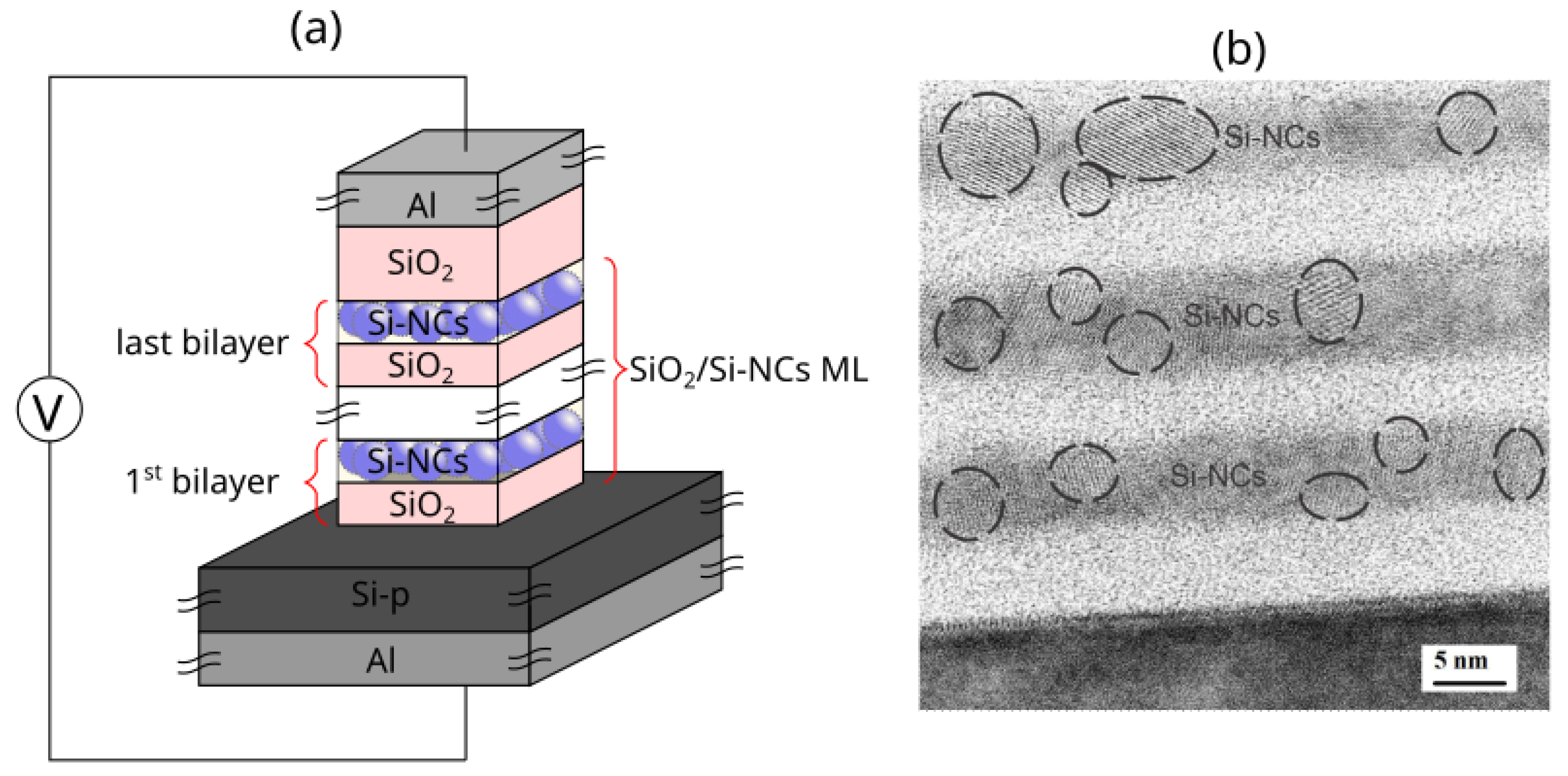
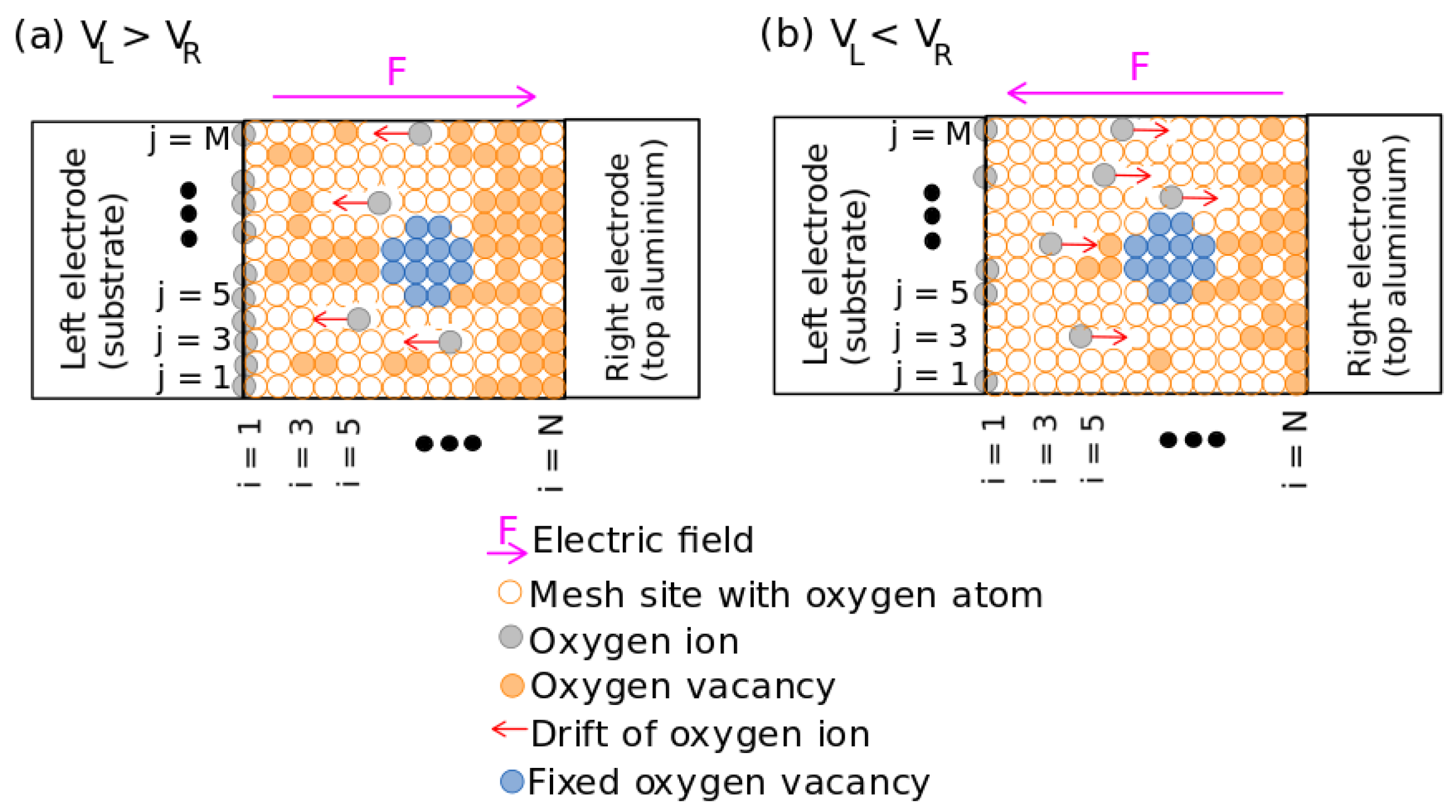
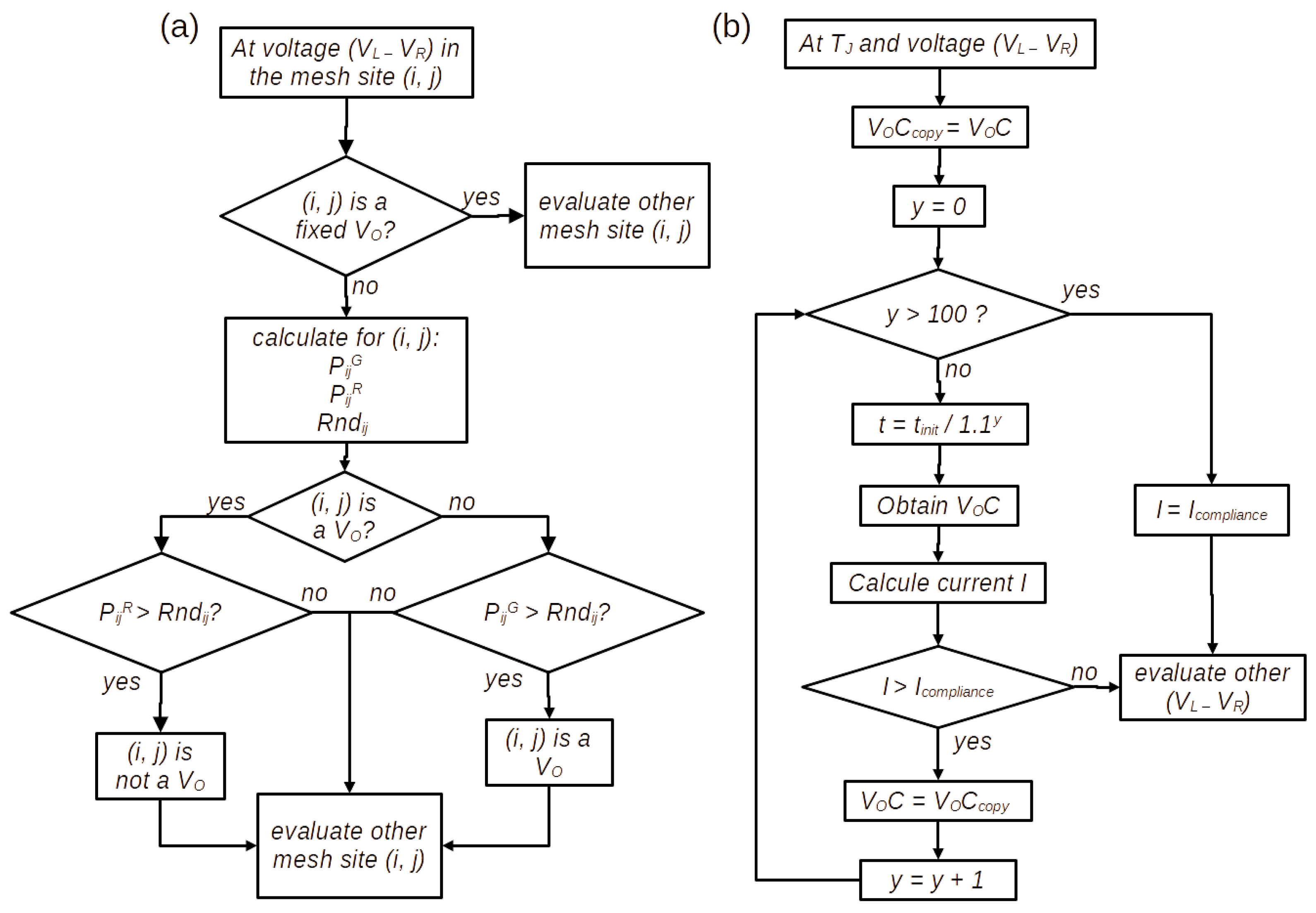

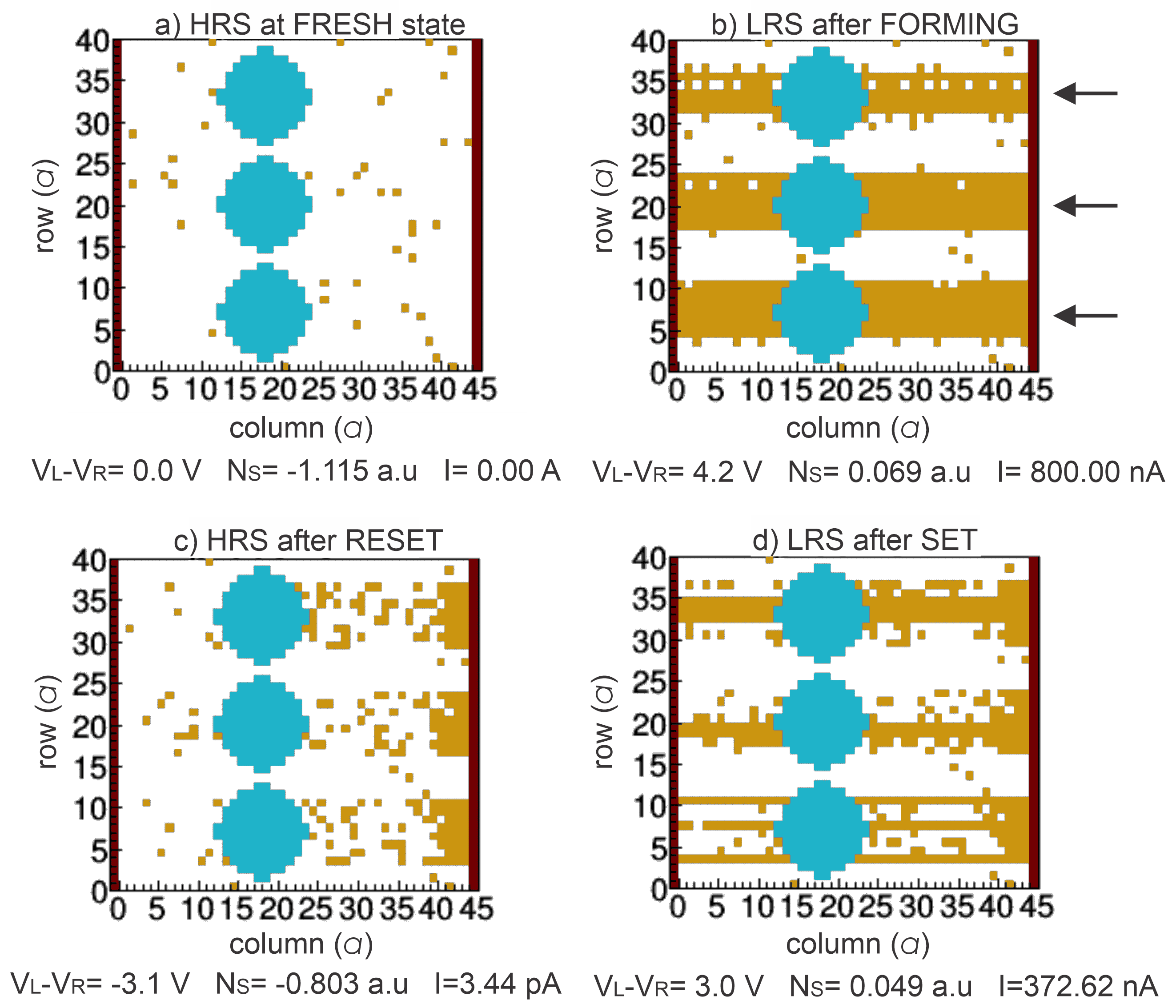
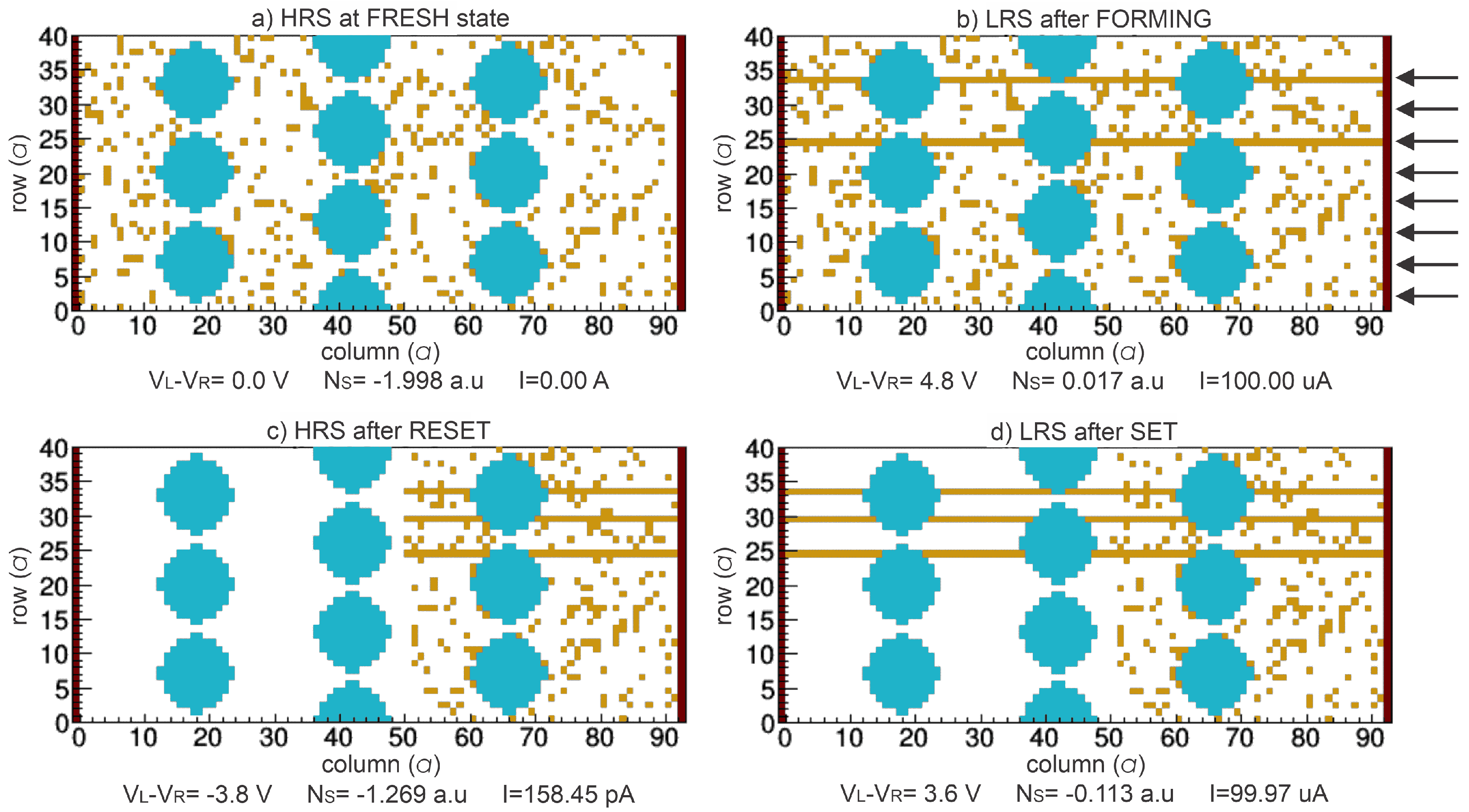
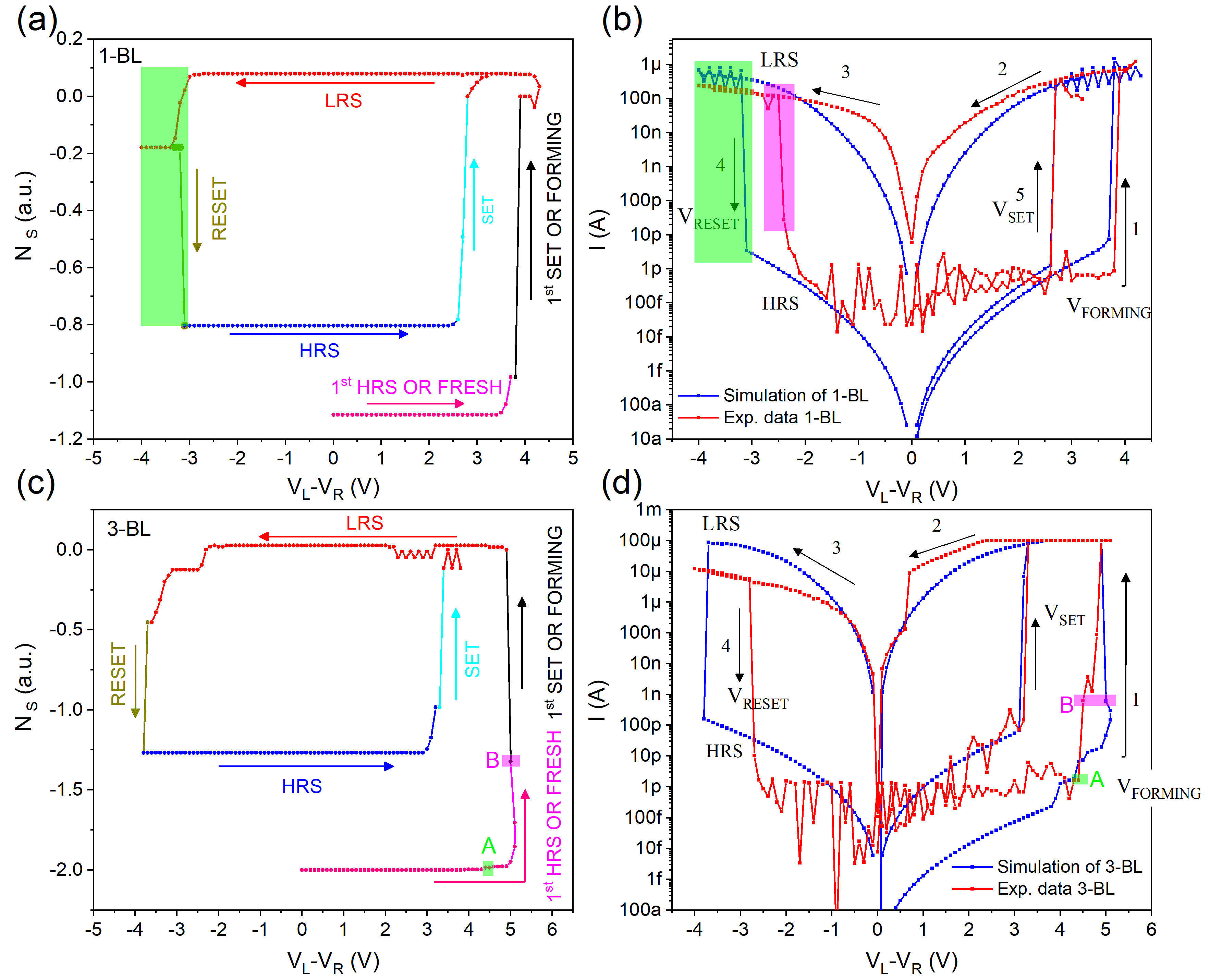

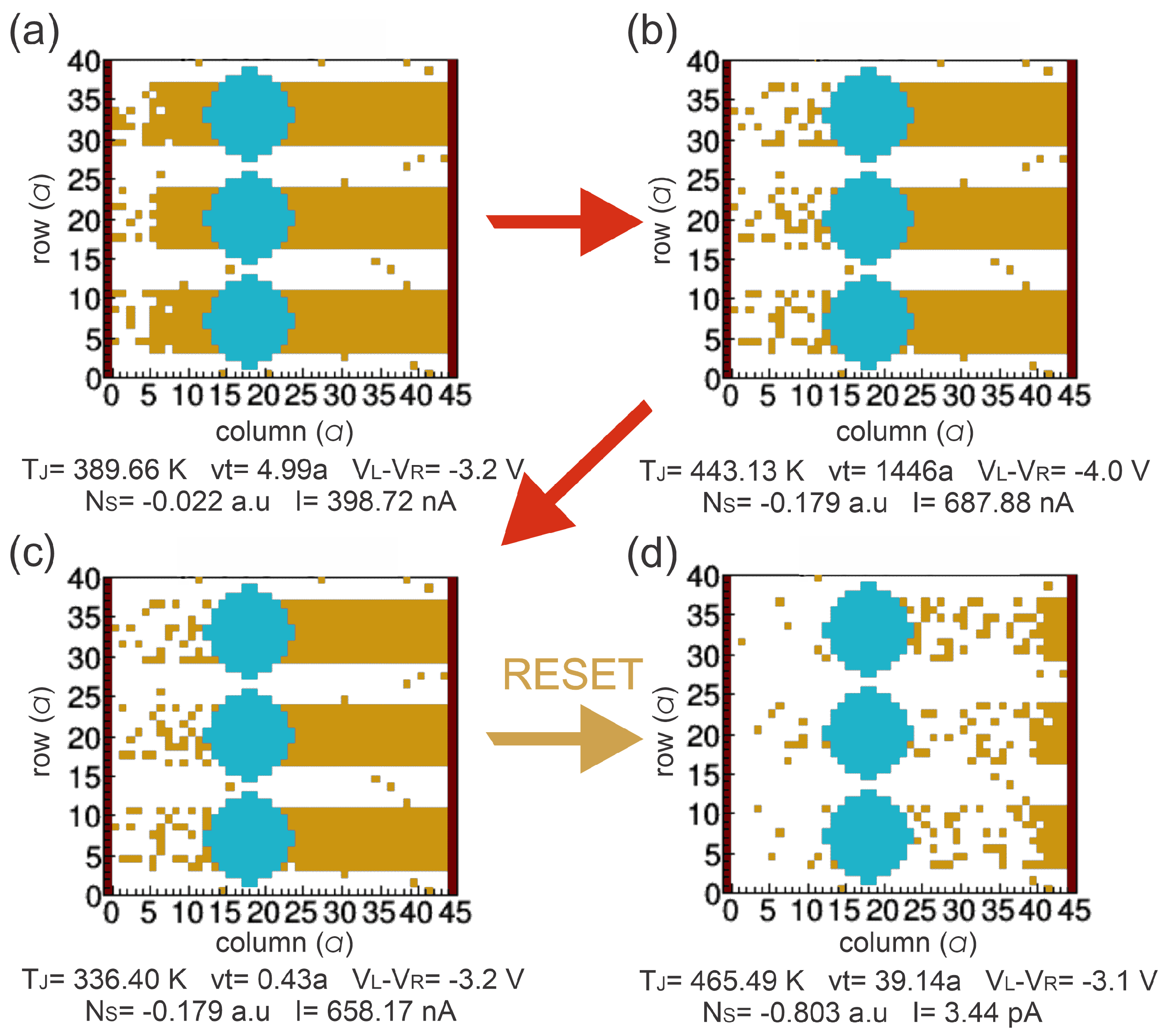
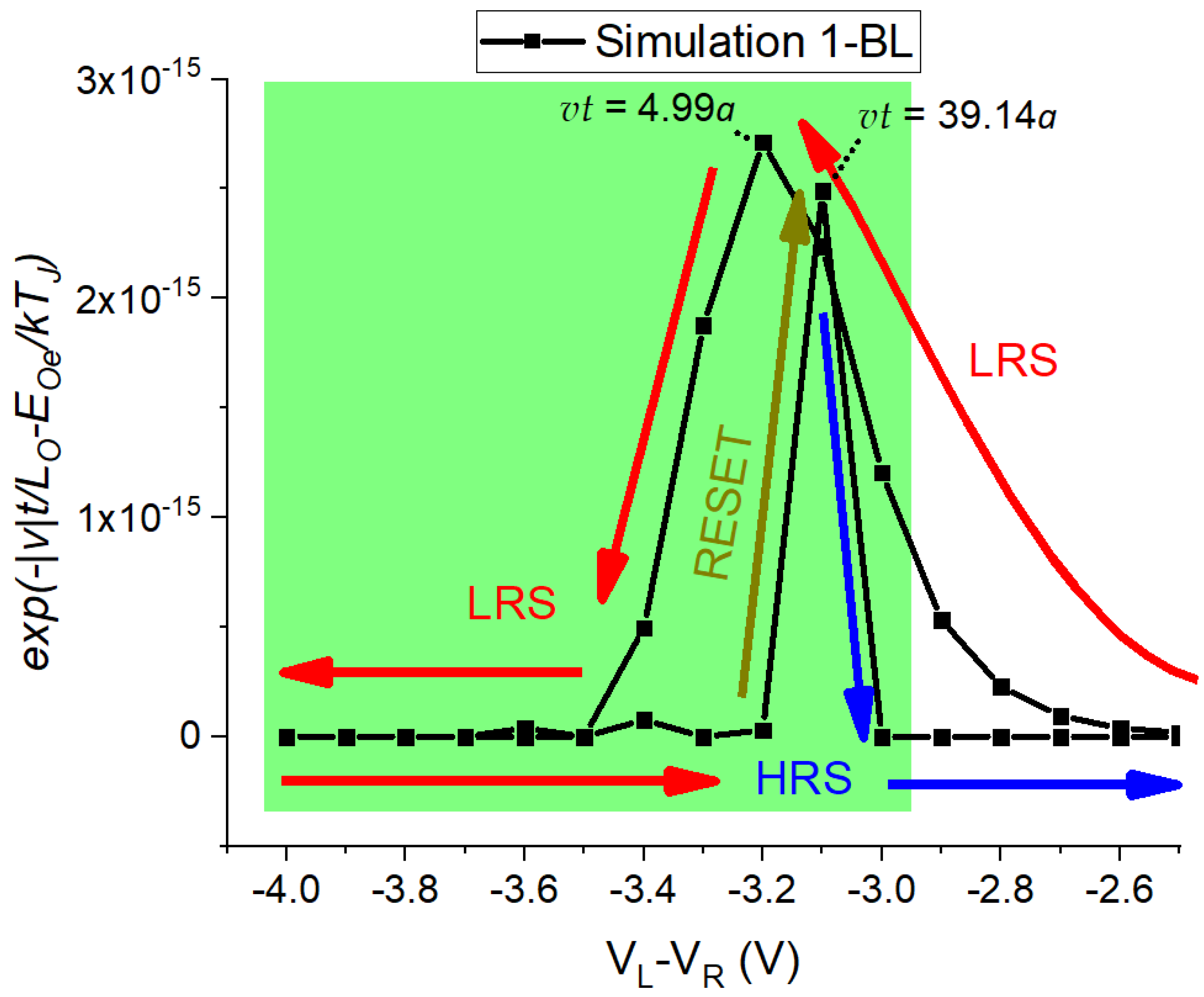
| Parameter | Symbol | 1-BL | 3-BL |
|---|---|---|---|
| Time to generate or recombine | 5 s | ||
| Vibration frequency of the | Hz | ||
| Migration barrier from oxygen equilibrium | 1 eV | ||
| Enhancement coefficient of generation probability during SET and FORMING | 4.6 | ||
| Enhancement coefficient of generation probability during RESET | 0.4 | ||
| Thickness of oxide | L | 22 nm | 46 nm |
| Initial number of | 40 | 400 | |
| Mesh size | a | 0.5 nm | |
| Coefficient for the recombination | |||
| Decaying length of the concentration | |||
| Height of the potential barriers during the migration of | 1 eV | ||
| Enhancement coefficient for the drift of | 8 | ||
| Attenuation length of the electron wave function | 0.33 nm | ||
| Enhancement factor for P-F mechanism | a.u. | a.u. | |
| Electron mobility | cm/Vs | ||
| Effective density of states in the conduction band | /cm | ||
| Electrical permittivity | F/cm | ||
| Potential of the trap levels for charge conductivity | 0.1 V | ||
| Enhancement factor of SCLC-F | a.u. | a.u. | |
| Device area | A | 1 mm | |
| Thermal resistance of CFs | K/W | K/W | |
| at LRS | 0.2 | ||
| at HRS | |||
| at fresh state | |||
Disclaimer/Publisher’s Note: The statements, opinions and data contained in all publications are solely those of the individual author(s) and contributor(s) and not of MDPI and/or the editor(s). MDPI and/or the editor(s) disclaim responsibility for any injury to people or property resulting from any ideas, methods, instructions or products referred to in the content. |
© 2023 by the authors. Licensee MDPI, Basel, Switzerland. This article is an open access article distributed under the terms and conditions of the Creative Commons Attribution (CC BY) license (https://creativecommons.org/licenses/by/4.0/).
Share and Cite
Ramirez-Rios, J.; González-Flores, K.E.; Avilés-Bravo, J.J.; Pérez-García, S.A.; Flores-Méndez, J.; Moreno-Moreno, M.; Morales-Sánchez, A. Semiempirical Two-Dimensional Model of the Bipolar Resistive Switching Process in Si-NCs/SiO2 Multilayers. Nanomaterials 2023, 13, 2124. https://doi.org/10.3390/nano13142124
Ramirez-Rios J, González-Flores KE, Avilés-Bravo JJ, Pérez-García SA, Flores-Méndez J, Moreno-Moreno M, Morales-Sánchez A. Semiempirical Two-Dimensional Model of the Bipolar Resistive Switching Process in Si-NCs/SiO2 Multilayers. Nanomaterials. 2023; 13(14):2124. https://doi.org/10.3390/nano13142124
Chicago/Turabian StyleRamirez-Rios, Juan, Karla Esther González-Flores, José Juan Avilés-Bravo, Sergio Alfonso Pérez-García, Javier Flores-Méndez, Mario Moreno-Moreno, and Alfredo Morales-Sánchez. 2023. "Semiempirical Two-Dimensional Model of the Bipolar Resistive Switching Process in Si-NCs/SiO2 Multilayers" Nanomaterials 13, no. 14: 2124. https://doi.org/10.3390/nano13142124
APA StyleRamirez-Rios, J., González-Flores, K. E., Avilés-Bravo, J. J., Pérez-García, S. A., Flores-Méndez, J., Moreno-Moreno, M., & Morales-Sánchez, A. (2023). Semiempirical Two-Dimensional Model of the Bipolar Resistive Switching Process in Si-NCs/SiO2 Multilayers. Nanomaterials, 13(14), 2124. https://doi.org/10.3390/nano13142124











